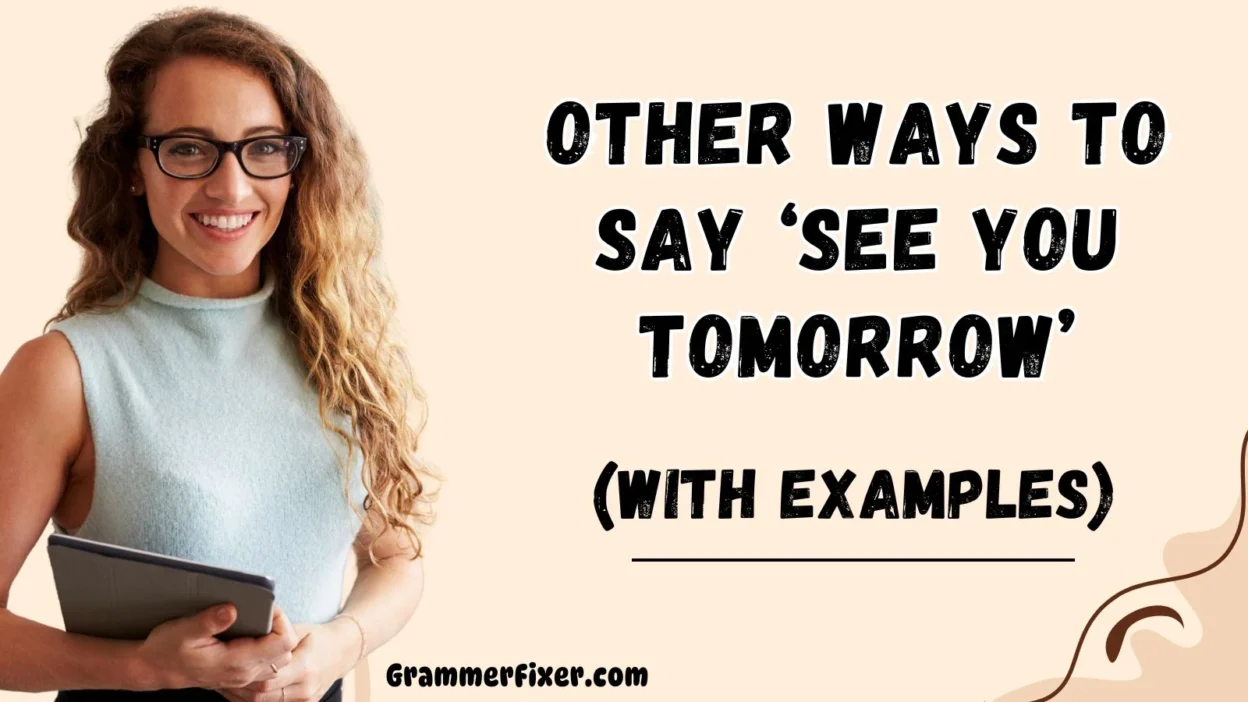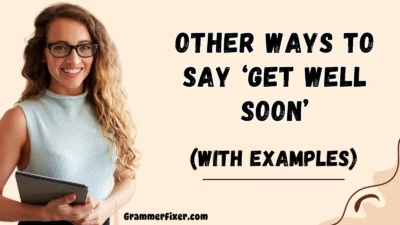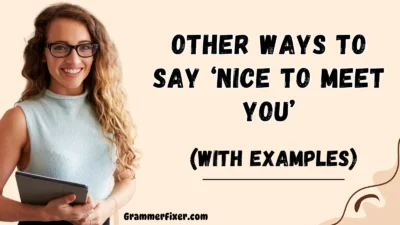Finding the right words when parting ways can turn a simple goodbye into a moment that leaves a lasting, warm impression. Whether you’re ending a meeting, wrapping up a day’s work, or saying farewell after a friendly conversation, using a thoughtful alternative to “See You Tomorrow” can help you express care, maintain professionalism, or simply brighten someone’s day.
These alternatives are designed to fit both casual and formal settings, ensuring you can communicate with confidence, respect, and a personal touch.
What Does “See You Tomorrow” Mean?
The phrase “See You Tomorrow” is a friendly and direct way to indicate that you will meet or connect with someone again on the next day. It works in face-to-face interactions, phone calls, emails, or messages, and implies a pre-established plan or anticipated encounter.
It’s simple, clear, and effective for personal, professional, and informal conversations.
Is It Professional/Polite to Say “See You Tomorrow”?
Yes — “See You Tomorrow” is generally polite and appropriate in both formal and casual settings. It works well in workplace environments, with colleagues, clients, or associates, as long as it matches the tone of the conversation.
In professional emails or messages, you might pair it with polite closings such as “Best regards” or “Take care” to enhance its warmth and professionalism.
Advantages and Disadvantages
Advantages:
- Clear and concise — leaves no room for misunderstanding
- Friendly and approachable tone
- Works across multiple contexts (emails, in-person, messages)
- Easy to remember and universally understood
Disadvantages:
- Might feel too routine or generic if overused
- Lacks personalization compared to creative alternatives
- May feel informal in high-stakes or formal situations
1. Talk to You Tomorrow
Meaning: A conversational alternative emphasizing communication rather than just seeing each other.
Detailed Explanation: This phrase suggests that you will speak with the person again tomorrow, whether in person, via phone, or digitally. It’s versatile for both work and personal contexts.
Scenario Examples:
- Casual: “Alright, I’ll talk to you tomorrow about the party plans.”
- Professional: “Thanks for the updates today. I’ll talk to you tomorrow during our check-in.”
Best Use: Ideal for situations where a conversation is expected the next day.
Tone: Friendly, casual, and slightly personal.
2. Catch You Tomorrow
Meaning: An informal, lighthearted farewell suggesting a friendly reconnection.
Detailed Explanation: Often used between friends, close colleagues, or in casual work settings, it feels relaxed and upbeat.
Scenario Examples:
- Casual: “Catch you tomorrow at the gym!”
- Professional (casual workplace): “Great ideas in the meeting today — catch you tomorrow for the follow-up.”
Best Use: Perfect for casual workplace environments or friendly interactions.
Tone: Warm, light, and easygoing.
3. See You in the Morning
Meaning: A more specific version of “See You Tomorrow,” pinpointing the time of day.
Detailed Explanation: Adds anticipation and a sense of schedule clarity, making it suitable for planned meetings.
Scenario Examples:
- Casual: “Sleep well — see you in the morning!”
- Professional: “The presentation’s set for 9 AM — see you in the morning.”
Best Use: Best for when time-specific meetings are arranged.
Tone: Friendly and slightly formal.
4. Until Tomorrow
Meaning: A succinct, elegant way to indicate the next meeting will be tomorrow.
Detailed Explanation: This phrase carries a gentle formality and works in both professional and personal communications.
Scenario Examples:
- Casual: “Thanks for today’s chat. Until tomorrow!”
- Professional: “I appreciate your insights — until tomorrow, then.”
Best Use: Useful in emails, calls, or polite conversations.
Tone: Calm, neutral, and respectful.
5. Let’s Pick This Up Tomorrow
Meaning: Suggests continuing a discussion or task the next day.
Detailed Explanation: Often used in meetings or projects, this phrase keeps the focus on continuity.
Scenario Examples:
- Casual: “We’ll figure out the menu later — let’s pick this up tomorrow.”
- Professional: “We’ve made great progress today — let’s pick this up tomorrow in our follow-up session.”
Best Use: Great for work-in-progress situations.
Tone: Practical, task-oriented, and collaborative.
6. Talk Soon, Tomorrow
Meaning: A friendly farewell that combines a promise to talk soon with the certainty of tomorrow.
Detailed Explanation: This blends warmth with a specific timeframe, making it ideal for maintaining connection without sounding overly formal.
Scenario Examples:
- Casual: “Safe travels home — talk soon, tomorrow!”
- Professional: “Thanks for your feedback today. Talk soon, tomorrow, during the project review.”
Best Use: Good for colleagues, friends, or clients when you want to keep the tone approachable but specific.
Tone: Friendly, optimistic, and open.
7. See You at the Meeting Tomorrow
Meaning: A specific alternative that clearly states where the next interaction will happen.
Detailed Explanation: Helps avoid ambiguity by tying the farewell to a scheduled event.
Scenario Examples:
- Casual: “Great ideas today — see you at the meeting tomorrow.”
- Professional: “I’ll bring the updated report — see you at the meeting tomorrow at 10 AM.”
Best Use: Ideal for planned professional gatherings.
Tone: Clear, organized, and professional.
8. Looking Forward to Tomorrow
Meaning: Expresses anticipation and a positive outlook for the next meeting.
Detailed Explanation: This phrase works especially well to convey excitement and optimism, either personally or professionally.
Scenario Examples:
- Casual: “It’s going to be fun — looking forward to tomorrow!”
- Professional: “Your presentation is always insightful — looking forward to tomorrow’s session.”
Best Use: Best when you want to encourage and motivate.
Tone: Positive, uplifting, and warm.
9. Until We Meet Again Tomorrow
Meaning: A poetic, slightly formal twist on the standard farewell.
Detailed Explanation: Adds a touch of elegance and emotional warmth, making the message feel personal and special.
Scenario Examples:
- Casual: “Thanks for today — until we meet again tomorrow.”
- Professional: “Your insights were invaluable — until we meet again tomorrow.”
Best Use: Perfect for closing thoughtful discussions.
Tone: Graceful, warm, and slightly formal.
10. Tomorrow’s Another Day — See You Then
Meaning: Adds a light, encouraging sentiment to the farewell.
Detailed Explanation: Suggests fresh starts and new opportunities while confirming tomorrow’s meeting.
Scenario Examples:
- Casual: “We’ll finish the DIY project later — tomorrow’s another day, see you then.”
- Professional: “Let’s approach it with fresh eyes — tomorrow’s another day, see you then.”
Best Use: Useful in situations requiring motivation or a positive outlook.
Tone: Encouraging, hopeful, and friendly.
11. We’ll Continue Tomorrow
Meaning: States clearly that the current discussion or task will resume the next day.
Detailed Explanation: Direct and goal-focused, often used in team settings or project work.
Scenario Examples:
- Casual: “We’re making great progress — we’ll continue tomorrow.”
- Professional: “Let’s wrap here — we’ll continue tomorrow with the final review.”
Best Use: Perfect for structured workflows.
Tone: Straightforward, professional, and efficient.
12. Bright and Early Tomorrow
Meaning: Suggests meeting first thing in the morning.
Detailed Explanation: Often conveys energy and enthusiasm, but also clarity about timing.
Scenario Examples:
- Casual: “Let’s go for coffee — bright and early tomorrow.”
- Professional: “We’ll start the training bright and early tomorrow.”
Best Use: Suitable for morning appointments.
Tone: Energetic, friendly, and clear.
13. I’ll See You Then
Meaning: Simple and adaptable, referring to a mutually understood meeting time.
Detailed Explanation: Works well when the next meeting time is already agreed upon.
Scenario Examples:
- Casual: “Alright, I’ll see you then!”
- Professional: “Thanks for confirming — I’ll see you then.”
Best Use: Best when timing has already been confirmed.
Tone: Neutral, versatile, and friendly.
14. Until the Sun Rises Tomorrow
Meaning: A creative, poetic farewell.
Detailed Explanation: Conveys warmth and anticipation with a touch of literary style.
Scenario Examples:
- Casual: “Sleep well — until the sun rises tomorrow.”
- Professional (friendly): “It’s been a productive day — until the sun rises tomorrow.”
Best Use: Ideal for friendly or creative environments.
Tone: Poetic, warm, and slightly whimsical.
15. Tomorrow, Same Time
Meaning: Specifies the meeting time clearly.
Detailed Explanation: Avoids confusion by reiterating the exact schedule.
Scenario Examples:
- Casual: “We’re on for coffee — tomorrow, same time.”
- Professional: “Our check-in stays at 3 PM — tomorrow, same time.”
Best Use: Works for recurring appointments.
Tone: Clear, direct, and organized.
16. See You First Thing Tomorrow
Meaning: Specifies an early meeting and conveys readiness.
Detailed Explanation: This phrase works well when you want to emphasize punctuality and a productive start.
Scenario Examples:
- Casual: “Don’t oversleep — see you first thing tomorrow!”
- Professional: “We’ll finalize the proposal — see you first thing tomorrow at 8:30.”
Best Use: Ideal for time-sensitive meetings.
Tone: Energetic, focused, and direct.
17. Let’s Continue This Tomorrow
Meaning: Indicates that a discussion or task will be resumed the next day.
Detailed Explanation: Keeps the momentum while also signaling closure for the current session.
Scenario Examples:
- Casual: “It’s getting late — let’s continue this tomorrow.”
- Professional: “We’ve covered a lot today — let’s continue this tomorrow during our strategy meeting.”
Best Use: Great for meetings, planning sessions, or brainstorming.
Tone: Collaborative, practical, and warm.
18. Tomorrow It Is
Meaning: Confirms tomorrow as the agreed-upon time.
Detailed Explanation: Simple, friendly, and confident — it’s both a confirmation and a farewell.
Scenario Examples:
- Casual: “Movie night? Tomorrow it is.”
- Professional: “Thanks for your availability — tomorrow it is.”
Best Use: Suitable for finalizing plans.
Tone: Confident, concise, and friendly.
19. Let’s Touch Base Tomorrow
Meaning: Common in professional settings to suggest a follow-up or check-in.
Detailed Explanation: It’s business-friendly but still approachable, signaling an update or progress discussion.
Scenario Examples:
- Casual (semi-professional): “I’ll send over the details and let’s touch base tomorrow.”
- Professional: “Once you’ve reviewed the draft, let’s touch base tomorrow to finalize.”
Best Use: Ideal for team projects, client communications, and ongoing collaborations.
Tone: Professional, cooperative, and polite.
20. We’ll Reconvene Tomorrow
Meaning: Indicates a scheduled regrouping or meeting.
Detailed Explanation: Has a formal undertone, making it perfect for structured business settings.
Scenario Examples:
- Casual (group project): “Let’s take a break — we’ll reconvene tomorrow.”
- Professional: “We’ll reconvene tomorrow to review the updated financial report.”
Best Use: Suitable for formal or semi-formal settings.
Tone: Formal, clear, and organized.
21. I’ll Check In with You Tomorrow
Meaning: A promise to follow up or maintain communication.
Detailed Explanation: Works well when accountability or progress updates are involved.
Scenario Examples:
- Casual: “Hope you feel better — I’ll check in with you tomorrow.”
- Professional: “Once the data comes in, I’ll check in with you tomorrow.”
Best Use: Best for follow-up commitments.
Tone: Caring, responsible, and reliable.
22. Tomorrow, We Continue
Meaning: Adds an element of anticipation and momentum.
Detailed Explanation: Works in settings where ongoing effort is needed, creating a team-focused vibe.
Scenario Examples:
- Casual: “We’re not done yet — tomorrow, we continue!”
- Professional: “The design phase is nearly there — tomorrow, we continue.”
Best Use: Perfect for motivating teams.
Tone: Motivational, positive, and forward-looking.
23. Let’s Wrap for Today and Meet Tomorrow
Meaning: Suggests ending the current activity with plans to reconvene tomorrow.
Detailed Explanation: Combines closure with a clear plan for the next day.
Scenario Examples:
- Casual: “It’s getting late — let’s wrap for today and meet tomorrow.”
- Professional: “We’ve achieved today’s goals — let’s wrap for today and meet tomorrow.”
Best Use: Great for closing meetings or day’s work.
Tone: Clear, decisive, and friendly.
24. Till Tomorrow
Meaning: Short, simple, and elegant.
Detailed Explanation: A timeless farewell, often used in both casual and professional contexts.
Scenario Examples:
- Casual: “It’s been fun — till tomorrow!”
- Professional: “Thank you for your time — till tomorrow.”
Best Use: Best for quick goodbyes with a polite tone.
Tone: Neutral, warm, and versatile.
25. We’ll Finalize Tomorrow
Meaning: Indicates that a decision or task will be completed the next day.
Detailed Explanation: Communicates confidence and focus on achieving closure.
Scenario Examples:
- Casual (planning event): “We’ll finalize tomorrow once everyone’s confirmed.”
- Professional: “We’ll finalize tomorrow after reviewing the last set of figures.”
Best Use: Great for project deadlines and task closures.
Tone: Focused, professional, and goal-driven.
26. Tomorrow’s Agenda Awaits
Meaning: Adds anticipation for scheduled activities the next day.
Detailed Explanation: Works well for planned meetings or events, keeping the tone motivated.
Scenario Examples:
- Casual: “Get some rest — tomorrow’s agenda awaits!”
- Professional: “Tomorrow’s agenda awaits, and we’re set for a productive day.”
Best Use: Perfect for motivating teams or pre-event preparation.
Tone: Inspirational, positive, and forward-looking.
27. See You After Sunrise
Meaning: A creative twist for morning meetings.
Detailed Explanation: Lighthearted and poetic, while still specifying timing.
Scenario Examples:
- Casual: “Breakfast plans? See you after sunrise.”
- Professional: “Workshop starts early — see you after sunrise.”
Best Use: Best for morning appointments.
Tone: Playful, creative, and friendly.
28. Tomorrow, We’ll Dive Deeper
Meaning: Suggests continuing a detailed discussion or project.
Detailed Explanation: Implies progress and depth in work or conversation.
Scenario Examples:
- Casual: “This is fascinating — tomorrow, we’ll dive deeper.”
- Professional: “We’ve covered the basics — tomorrow, we’ll dive deeper into solutions.”
Best Use: Suitable for strategic discussions or training sessions.
Tone: Professional, curious, and motivating.
29. Until Our Paths Cross Tomorrow
Meaning: A poetic way to say you’ll see someone tomorrow.
Detailed Explanation: Adds warmth and thoughtfulness to a simple farewell.
Scenario Examples:
- Casual: “It’s been lovely — until our paths cross tomorrow.”
- Professional: “Until our paths cross tomorrow, have a restful evening.”
Best Use: Ideal for friendly professional relationships.
Tone: Elegant, warm, and memorable.
30. Tomorrow, Same Place
Meaning: Confirms the next day’s location.
Detailed Explanation: Keeps scheduling clear while maintaining a friendly tone.
Scenario Examples:
- Casual: “Lunch at the café? Tomorrow, same place.”
- Professional: “The workshop will resume — tomorrow, same place.”
Best Use: Great for location-specific meetings.
Tone: Clear, friendly, and efficient.
Conclusion
Saying “See You Tomorrow” doesn’t have to be routine. With these 30 thoughtful alternatives, you can make your farewells warmer, more engaging, and more memorable. Whether you’re speaking to friends, colleagues, or clients, the right phrase can set the tone for your next meeting, reaffirm your commitment, and strengthen your connection.
By choosing your words with care, you not only convey the message but also the value you place on the relationship — ensuring every parting leaves a positive impression.
FAQs About Saying “See You Tomorrow” and Its Alternatives
1. Is “See You Tomorrow” formal or informal?
Answer: “See You Tomorrow” is generally informal to semi-formal. It’s perfectly acceptable in most workplace settings, but for very formal communication, you might opt for phrases like “I look forward to our meeting tomorrow” or “I’ll follow up with you tomorrow.”
2. Can I use “See You Tomorrow” in an email?
Answer: Yes. It works in emails as long as it suits the tone and context. For professional emails, pair it with a closing line such as “Best regards” or “Sincerely” to keep it polite and professional.
3. What’s a more professional alternative to “See You Tomorrow”?
Answer: Professional alternatives include “I’ll follow up with you tomorrow”, “We’ll reconvene tomorrow”, or “I’ll check in with you tomorrow”, especially in business or client communications.
4. Are there creative ways to say “See You Tomorrow”?
Answer: Yes — creative options like “Until the sun rises tomorrow”, “Until our paths cross tomorrow”, or “See you after sunrise” add poetic flair and a personal touch to your farewell.
5. Why should I use alternatives to “See You Tomorrow”?
Answer: Using alternatives keeps your communication fresh, personalized, and memorable. It helps maintain rapport, avoid repetition, and tailor your message to different relationships and settings.



